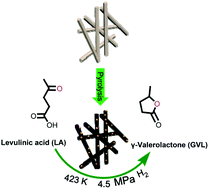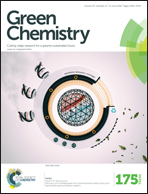A smart strategy to fabricate Ru nanoparticle inserted porous carbon nanofibers as highly efficient levulinic acid hydrogenation catalysts†
Abstract
Herein, we first put forward a smart strategy to in situ fabricate Ru nanoparticle (NP) inserted porous carbon nanofibers by one-pot conversion of Ru-functionalized metal organic framework fibers. Such fiber precursors are skillfully constructed by cooperative assembly of different proportional RuCl3 and Zn(Ac)2·2H2O along with trimesic acid (H3BTC) in the presence of N,N-dimethylformamide. The following high-temperature pyrolysis affords uniform and evenly dispersed Ru NPs (ca. 12–16 nm), which are firmly inserted into the hierarchically porous carbon nanofibers formed simultaneously. The resulting Ru-carbon nanofiber (Ru-CNF) catalysts prove to be active towards the liquid-phase hydrogenation of levulinic acid (LA) to γ-valerolactone (GVL), a biomass-derived platform molecule with wide applications in the preparation of renewable chemicals and liquid transportation fuels. The optimal GVL yield of 96.0% is obtained, corresponding to a high activity of 9.56 molLA h−1 gRu−1, 18 times that of using the commercial Ru/C catalyst. Moreover, the Ru-CNF catalyst is extremely stable, and can be cycled up to 7 times without significant loss of reactivity. Our strategy demonstrated here reveals new possibilities to make proficient metal catalysts, and provides a general way to fabricate metal–carbon nanofiber composites available for other applications.


 Please wait while we load your content...
Please wait while we load your content...